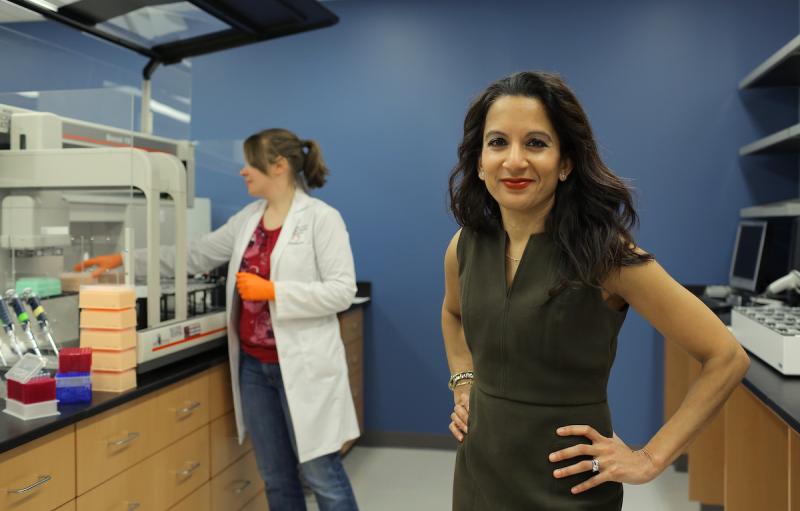
In 2016, the Duke School of Medicine selected 38 of its faculty for the new Duke Health Scholars and Duke Health Fellows Program. With funds from the Duke University Health System, the program supports the research efforts of early to mid-career clinician-scientists at Duke.
Among the faculty honored are 14 individuals from the Department of Medicine, including Svati Shah, MD, MPH, MHS, associate professor of medicine (Cardiology) and associate director of the Cardiovascular Disease Fellowship Program.
When Svati Shah finished training as a doctor-scientist in the mid-2000s, genetic research promised to expose the roots of common illnesses.
Then came the letdown.
Comparative genomic studies found DNA sequence profiles that, on average, only slightly increase risks for common health burdens. Just as frustrating, the results rarely expose the functional importance of genetic differences.
But Shah, a cardiologist with a passion for genetic epidemiology, didn’t turn back. Instead she mapped a different route to discovery, harnessing big data tools to compare multiple molecular differences beyond static DNA among patients to better understand health risks.
The result: she and collaborators are uncovering previously unknown biomarkers that may be new targets for prevention, diagnosis, and treatment of disease.
“Svati is an incredibly prolific and scientifically accomplished individual. Her work is highly translational, mechanistic and of high scientific impact,” says Scott Palmer, MD, MHS, vice chair of research for the Department of Medicine.
The American-born daughter of immigrants from North India, Shah early on observed the value of good medical care, from its absence. Without treatment easily available in the United States, both of her grandfathers in India went blind from cataract disease, which wrecked their financial stability.
During high school in rural eastern Washington state, Shah discovered that she liked looking at vital parts of living things too. When a biology teacher tried to shock her by putting a fetal pig brain into palm, Shah did not flinch. She was too busy examining its structure, she recalled.
“I said: ‘This is the most incredible thing I’ve ever seen.’ I was hooked,” Shah said.
From the start, Shah customized her studies to serve a desire to address health needs at the population and the individual patient level. After completing biology and psychology studies at Johns Hopkins University, she stuck around Baltimore to earn a master’s degree in epidemiology, focusing on psychiatric epidemiology.
The training in statistics she received there, and the fundamentals of clinical research “set the core of everything I’ve done in research,” Shah said.
During medical school at the University of Washington, she was more intrigued by the problems in cardiology than by the medicines commonly dispensed in psychiatry.
A mentor during her residency at Brigham and Women’s Hospital in Boston recommended she consider the newly emerging field genetic epidemiology to dig into disease origins. So, during her cardiovascular medicine fellowship at Duke, she added a degree in medical genomics to her toolbox.
Soon after joining Duke’s faculty in 2005, Shah co-authored a paper reporting the first gene implicated in early onset coronary disease. But the effect size was tiny, much lower than risks from cigarette smoking. And how the genes in question contributed to harm was not clear.
“It only slightly incrementally increased our knowledge of the inheritability of heart disease,” Shah said.
Now Shah and collaborators merge comparisons of metabolites, gene transcription, and gene regulation with DNA sequence in comparative studies. A paper published in 2015 in PLOS Genetics demonstrates the power of this approach.
After probing a million data points in samples from 3,700 patients, Shah and collaborators identified a pathway active in some heart attacks and heart disease deaths. Certain genetic profiles, it turns out, make a the cell organelle endoplasmic reticulum more vulnerable to stress. Because the reticula are so vital to protein synthesis, folding, modification, and transport, disarray can trip up normal cell functions.
In this pursuit, blood becomes a liquid biopsy, potentially clarifying aspects of a patient’s disease the way tumor biopsies can inform oncologists. “These tiny things we measure in the blood could help us personalize how we take care of patients,” Shah said.
But Shah isn’t waiting for someday to have an impact with patients.
She founded and directs the Duke Adult Cardiovascular Genetics clinic, the only one of its kind in the Southeast. She and colleagues study and treat inherited heart diseases such as hypertrophic cardiomyopathy, long QT syndrome and Brugada syndrome, frequently dangerous conditions linked to known genes that family members may well inherit.
“We are able to test them and tell them: You are at risk, or not at risk. If they are, we can watch them very closely,” Shah said.
Shah is hoping to get genetic data better integrated into many more Duke patient medical records, opening the door for such information help guide treatment of everyone for everything, including common troublemakers such as heart disease and obesity.
In other words, Shah remains committed to her original project: to expand good medical care. Fast computers, powerful software, smart statistics, and lots of biological samples are helping her get the job done.
The series of profiles of our Duke Health Scholars were written by Catherine Clabby, freelance science journalist. Photos are by Ted Richardson.